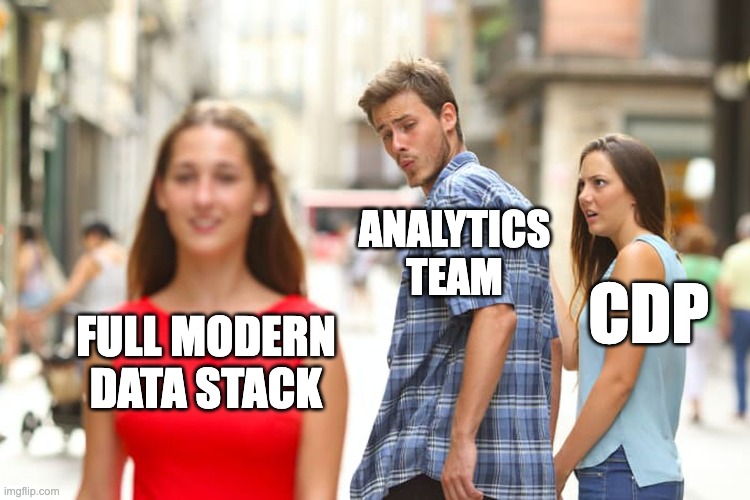In today’s era of digitization, businesses are inundated with vast amounts of data from diverse sources. Harnessing this data effectively is not just a competitive advantage; it’s a necessity for survival. While there are many tools available to manage and analyze customer data, two of the most common options businesses consider are a cloud data warehouse vs a Customer Data Platform (CDP).
In many ways, it’s the old “build vs buy” dilemma. Should you build your own modern data stack with a cloud data warehouse like Snowflake or Databricks (an approach that is often referred to as a “composable CDP”), or should you buy an out-of-the-box CDP? In the past, organizations with small data teams or limited technical expertise turned to CDPs. Put simply, it seemed like the best way to collect customer data and stitch it into a “360-degree view.”
That’s certainly not the case anymore.

Technology has changed, and unit economics have made it significantly easier to adopt your own composable solution. As we covered in our previous article on CDP alternatives, adding an activation tool on top of your data warehouse gives you many of the benefits of a CDP at a fraction of the cost.
But what if your organization doesn’t have a cloud data warehouse and/or you lack the technical expertise to implement a full modern data stack? Or what if you’ve already invested in a CDP and the idea of switching seems somewhat daunting? Data Clymer has worked with a number of organizations that previously invested in a CDP and transitioned to a modern data stack. These teams gained flexibility, improved analytics, reduced costs, and set themselves up for long-term success.
Here are six reasons why a cloud data warehouse vs a CDP is a smarter choice.
1: Comprehensive Data Management
CDPs primarily focus on collecting and unifying customer data from various touchpoints to provide a 360-degree view of the customer. While this is crucial for improving customer experiences, a data and analytics solution that is built on a cloud data warehouse (such as Snowflake or Databricks) takes it several steps further.
By having a complete modern data stack, you can combine customer data from various sources. You can also add other sources like operations, finance, HR, and more. This single source of truth shows a holistic view of the entire business—not just of customers—allowing better decisions by all departments.
2: Flexibility and Customization
CDPs are usually out-of-the-box solutions with limited flexibility. While they may offer some customization, businesses often have to adapt their processes to the constraints of the CDP platform. In contrast, building a cloud data warehouse provides a high level of customization and flexibility. Businesses can design and build their warehouse to fit their unique needs, workflows, and goals.
For example, when the NFL Raiders moved from Oakland to Las Vegas, they faced a unique opportunity. Situated in a major tourism hub, they owned the city’s largest venue: their stadium. The city’s massive tourist market and potential casino partners presented new revenue streams and fan engagement opportunities. The Raiders partnered with Data Clymer to build a new modern data stack that gave them the flexibility they needed to achieve success.
Explore a collection of resources on data analytics in sports
Consider another pro sports example. Teams sell diverse ticket packages to different customers: season ticket holders, corporate partners, and one-time fans. Such unique setups don’t fit standard CDP models, resulting in an incomplete view of interactions. A cloud data warehouse allows for fully customizable data models to capture even intricate customer behavior details.
Last but not least, cloud data warehouses are increasingly building out application marketplaces (such as the Snowflake Marketplace) to give businesses streamlined access to an ever-increasing number of applications. As a result, businesses can capitalize on even more data-related use cases directly from their cloud data warehouse.
3: Enhanced Analytical Capabilities
A cloud data warehouse enables advanced analyses on diverse data types, revealing deeper insights and fostering innovation. Combined with a marketing activation tool (such as Census, Hightouch, or GrowthLoop), organizations can leverage these insights to drive targeted marketing campaigns. They can also send data and customer segments to their source systems like Salesforce or HubSpot. This, in turn, accelerates marketing automation and promotes personalization.
Meanwhile, a CDP’s analytical scope might only cover customer behavior, not fully supporting complex modern business analysis. CDPs will also rarely have the ability to push any customer segmentation back into source CRM and marketing automation platforms.
4: Cost Considerations
Although CDPs may appear budget-friendly at first, extra charges can arise for larger data volumes and advanced features. Long-term contracts and additional fees for desired functions or new data sources are common.
In contrast, cloud data warehouses follow a pay-as-you-go approach, often proving more economical over time. You only pay for the storage and compute resources you use, and you can scale these up or down as your needs change. Moreover, businesses can tap into an increasing number of resources and free tools to optimize their data warehouse spend, such as this dbt package for Snowflake. Third-party data observability tools like Monte Carlo, Kensu, and Metaplane can also provide the visibility businesses need to stay within their budget requirements.
5: Long-term Scalability
CDPs handle customer data well, but might struggle with big volumes and diverse types. In contrast, cloud data warehouses, are built for scale. They take advantage of the near infinite compute and storage resources provided by various cloud platform providers (such as AWS, GCP, and Azure).
As your business grows, so too will your data needs and the types of data that you want to manage. A cloud data warehouse, with its superior scalability and ability to support multiple data types, can accommodate this growth more efficiently.
How an Award-Winning Non-Profit Scaled for Growth with a Modern Data Stack
6: Data Security
Both CDPs and cloud data warehouses prioritize data security. However, the latter often provides more robust security features, including advanced encryption methods and granular access controls. Businesses with a cloud data warehouse can choose solutions based on data security preferences.
For example, organizations in the financial services sector who are on Snowflake and concerned about data privacy can select the Snowflake Business Critical Edition, which offers PCI compliance, cloud provider PrivateLink support, and business continuity options. Furthermore, the cloud service provider handles infrastructure security and compliance audits like SAS 70 Type II. This can provide a more secure environment than a CDP solution and provide peace of mind to customers.
Is Your Business Considering a Cloud Data Warehouse vs a CDP?
Sure, CDPs have their merits for specific marketing and customer engagement tasks. However, a cloud data warehouse offers broader and more adaptable control. It also equips businesses with advanced analytics, scalability, cost-efficiency, and data security. So if you’re looking for a holistic view of your customer and opportunities to grow and scale, a cloud data warehouse could be the strategic move your business needs.
Lacking the in-house data resources and expertise you need to build a full modern data stack? Data Clymer can help. We offer modern data architecture services and data strategy consulting to help you develop and execute on a roadmap for long-term success. Contact us today for a free strategy consultation.





